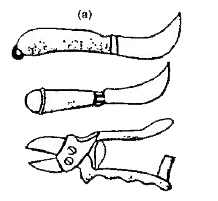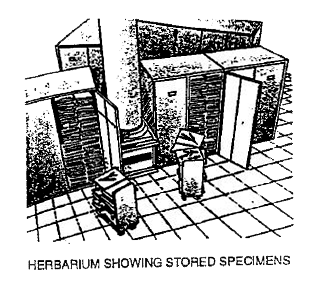What do you understand by herbarium? Explain the various steps in preparing herbarium.
Text Solution
A herbarium .is defined as a collection of piants which have been dried, pressed and preserveq on sheets. The sheets are arranged in accordance with any accepted system of classification.
Steps of making lzerbarium . There are following steps used for making a herbarium:
1. The collection of specimens requires regular field visits.
2. We have to get information about the place, habitat, season and the time of collection.
3. The field visit helps to give information about environmental conditions and human impact on the area.

4. One has to carry certain simple tools for collection of specimens or their parts.
5. The individual parts of a plant are useful in identification. In the field, one requires digger for digging roots, scissors for cutting twjgs, knife for woody twigs and a pole with a hook for coliecting parts of tall trees.

6. The collected specimens are carried in a box called vasculum to avoid loss of moisture and distortions by drying and shrivelling up. Polythene bags are also used for carrying the specimens.
7. Taxonomy students should carry a field .notebook for recording every detail rather than depending upon the memory.
8. The care is to be taken-to ensure that in the case of herbs both vegetative and reproductive parts are to be collected as plant specimen. However, twigs with leaves, inflorescence and flowers are collected from the shrubs and trees.
9. Sufficient number (5-6) of individual specimens of a particular kind are collected. This is necessary in case of damage during the process of carrying and preservation.
10. The specimens are referred to by the assigned collectimi numbers, which are called the field numbers.
11. The specimens are spread out, in shortest possible time.
12. They are dried by keeping tllem between .the folds of old newspapers. It is necess,uy to change these papers at regular intervals to avoid fungal growth.
13. Complete specimens with all parts are dried in a plant press. (The plant press consists of a set of two boards with straps, which help in tightening the newspaper sheets with specimens between the boards.)
14. The bigger specimens are not cnt but these are folded generally in n or w form.
15. Some ]eaves are spread for showing dorsal surface and others to show ventral surface.
16. The dried specimens are pasted on the herbarium sheets of standard size (29 x 41 cm).
17. Specimens before fixing are kept upside down on paper sheets. Glue or adhesive material is applied and they are mounted on the herbarium sheets.
18. All the pasted specimens are sprayed with fungicides like 0· 1 solution of mercuric chloride, pesticides like DDT, naphthalene and carbon disulphide to check the growth of fungus.

19. The heavy parts of plant like seeds, fruits are put in a packet and attached to the sheet.
20. It is necessary to label each herbarium sheet. It should carry the information about place, name of collector, date and time, common english name, vernacular name and scientific name of the species along with author.s name. The name of the family and genus are also given in the case of already identified species.
21. The sheets are arranged according to a particular system of classification and stored preferably in metallic cupboards. The area is disinfected to control insects and other pests and humidity is monitored to check fungal growth.
22. The information about the ·specimens is compiled and published in a form .of book (flora), which gives a list of total plant species in a particular region together with a brief-description.
|
Updated on:21/07/2023
Similar Questions
What do you understand by herbarium? Explain the various steps involved in preparing a herbarium specimen.
View SolutionWhat do you understand by a herbarium? Explain the various steps involved in preparing a herbarium specimen.
View SolutionWhat do you understand by puberty?
View SolutionWhat do you understand by alloys?
View SolutionWhat do you understand by atmosphere?
View SolutionWhat do you understand by vassalage?
View SolutionWhat do you understand by 'peasant raj'?Explain.
View SolutionWhat do you understand by symbiosis ? Explain with an example
View SolutionWhat do you understand by virtual image. Explain with examples.
View SolutionWhat do you understand by hybridisation? Explain with examples the various types of hybridisation involving s and p-orbitals.
View Solution

